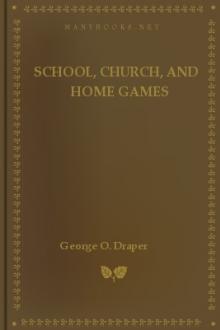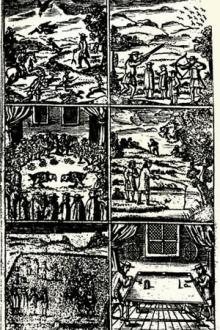School, Church, and Home Games, George Orrin Draper [best classic literature .TXT] 📗

- Author: George Orrin Draper
- Performer: -
Book online «School, Church, and Home Games, George Orrin Draper [best classic literature .TXT] 📗». Author George Orrin Draper
After all of the farmers have been discovered those who are to be farmers in the next round hide and the game goes on as before.
In case two red coats discover the same farmer the one first tagging him shall count and shall race with him for the goal. In case the red coat discovers more than one farmer he may choose the one he wishes to tag, but he is not to disclose the other to another red coat.
"Yankee Doodle Tag"
The group is divided into two equal teams. Two lines are marked upon the playing space parallel to each other and about 20 yards apart. These lines should be long enough to allow all of the expected number of players to form line upon, shoulder to shoulder. Each team lines up on a goal line facing in the same direction, Team A facing the center of the playing space, Team B facing away from the center.
Team A marches forward whistling "Yankee Doodle" maintaining a straight line until a leader who takes a position near the center of one side of the playing space raises a hand above his head. This is a signal for team A to stop whistling, break ranks and run back to their goal line.
Team B, whose backs are toward the advancing column, upon hearing the whistling stops, turns about and chases after team A, trying to tag as many of them as possible before they get back to their goal line. Every member of team A who is tagged becomes a member of team B.
Team B next marches forward whistling as did A, while A waits on their goal line until the whistling stops, thereupon they turn about and chase B. The game continues in this way. At the end the team having the most players is declared the winner.
Note—the leader giving the signal for the whistling to stop should take a position where the signal cannot be seen by the team waiting to chase the whistlers.
"Paul Revere Race"
The group is divided into teams of from 8 to 15 each. These teams are placed on the field in parallel columns of file with a distance of 10 feet between each team. The players on each team are then arranged in the line at a distance of from 10 to 20 feet apart. The lightest member of each team is selected as the rider for that team and takes his position behind the player at the back end of his line.
At the signal to start he leaps upon the back of the last man who carries him forward to the next man of his team in front of him in the line, and the rider must change from the back of the first steed to the back of the second without touching the ground. The second steed carries him to the third, and he is passed on from steed to steed until he reaches the last steed at the end of the column who carries him across a finish line. The first Paul Revere to cross the line wins the game for his team.
"The Midnight Ride"—Quiet Games
Two teams of equal numbers are chosen and arranged in two lines facing each other. If the game is played in-doors place the teams on opposite sides of the room. A pad of paper and a pencil is given to the two players at the head of each line. The leader then reads a number of lines from Longfellow's poem "The Midnight Ride of Paul Revere", requesting that all of the players endeavor to remember as much of the poem as possible. When a sufficient number of lines have been read the player at the head of each team, at a signal to start, writes the first word of the poem on the sheet and passes it along to the next player in line who writes the second word. And so it is passed until it reaches the end of the line. If a player does not remember the right word he writes his surname in place of the word and passes it on to the next player who either fills in the proper word or writes in the surname.
The team which passes the pad to the other end of the line first wins, provided that every one has either written a word from the poem or a name thereupon, and scores 5 points. The team having the fewest names written into the poem also scores 5 points (an error counts the same as a name). In case of a tie, the score race is repeated.
MODIFICATION.—Read several verses and require the paper to be passed up the lines and back as many times as are necessary to write down all of the verses read, using the same method used in the other race. The team first getting all of the verses written, wins. Those who cannot add the right word to the verse must write their surname in every time the paper passes them. Forfeits can be required from them whose names appear above a certain number of times on a sheet. If the group is very large increase the number of teams.
The above games are supposed to be played after the reading of Longfellow's poem—"The Midnight Ride of Paul Revere".
They are still talking about the Indoors Sports Fair that the Welfare League of Ashton gave last spring, and ranking it as the best thing the town ever did to raise money for their united welfare funds.
When the doors were opened on the first night it was not surprising to see a crowd all ready to push in and enjoy the sports prepared for them. No admission was charged, but each sport, exhibit and event had its price plainly marked in black on a bright blue sign at the entrance.
That first evening it seemed as if the golf course was patronized as freely as any of the sports. It took up one large corner of the hall, where a miniature nine-hole course had been laid out on dark blue denim. The "holes" were marked out with rings of white paint, and there were a few hazards of sandbags and a very low brick wall. For the most part it was a putting game, a putter being handed to the player after he had paid his admission to the "caddie" at the turnstile gate.
They say the boys had the time of their lives at the baseball diamond, and some of their fathers too, to judge from the receipts. Back on a large piece of canvas Bill Simons had "dashed in" with cold water paints a baseball diamond, with trees in the background and bleachers on each side, all in a queer perspective which didn't hurt the game any. In the curtain Bill had cut holes just a little larger than a baseball, so that throwing the ball through these holes was not any bush-league business. On the diamond he had marked under the holes, First Base, Second Base, Third Base, and Home Run at the plate. Back of the plate were two holes quite close together, one marked Strike and the other Ball. Two holes in the outfield and two "over the fence" were also arranged in pairs to make pitching difficult. Regular baseballs were sold, four shots for a nickel. The ruling of the game was simple: Three strikes out, four balls a chance to try first base, or one of the "over the fence" holes for a home run; after first base, second and third had to be hit successively before a home run could be scored, and to make it harder there was a "grounder" hole near third base which put one out of the game; balls which merely struck the curtain were counted as fouls, four fouls being out. Back of the curtain Bill had hung an old mattress against which the balls bounded to the floor. This was covered with a black cloth to make the holes in the diamond visible.
Seeing the Old Home Town
Down the line next to the baseball diamond came the bowling alley, where everyone who was not a fan or a golf fiend was taking a hand at the sport. This alley was laid on a long board table, and the game played with tenpins and small wooden balls. Six balls for a nickel they sold here, and because the sport needed something to speed it up a bit they linked it with the food table next door. The best cooks in town presided over this. You paid your money for your tenpin balls, and proceeded to run up a score by counting the numbers on the pins you knocked down; the pins were set far apart to make it difficult. Then you took your score to the food table, where certain numbers of points brought you a glass of jelly, a can of mince-meat, a box of cookies, or a jar of mayonnaise. That bowling alley certainly did appeal to the women!
And if there was ever a more successful grab bag for the children than the quoits game, the Ashton Welfare Committee wants to hear about it. They called it a Good Luck booth for it had a horseshoe-shaped opening with a row of numbered pegs across the back. The kiddies bought the quoits, little wooden horseshoes cut from cigar-box wood, and tossed them over a peg. The number of the peg corresponded to a numbered tag which was handed out to be redeemed at the parcel-post window near the aërial mail plane.
This aviator, by the way, was an official of the Cupid Airline, so he advertised on his aëroplane, which was painted on a large curtain with a hole cut out where the seat would be, and the wheel of an electric fan poked through at the front and set going for a propeller. His mail bag hung over the side of the car inside of which he stood in aviation uniform, and for ten cents you could get your fortune in a small white envelope out of the mail bag if you were a man, or in a pink envelope if you were a girl.
But say, for a real scream, you had to take a sight-seeing trip in the auto! It was worth twice the toll. Dottie Earle had charge of it, and she made one of the funniest guides you ever heard. "This way, ladies and gentlemen," she would shout through her megaphone; "get your tickets for a tour of the city in the most magnificently equipped sight-seeing autos that ever ran on three wheels and one cylinder! Only twenty-five cents, two bits a ride! See the birthplace of Ashton's mayor, the history of Ashton's past, its chief industries," and so on.
When her tourists assembled in front of her machine, which was a real car, at least the front half of one, an old relic which the garage had just about decided to scrap, its latter half hidden behind a dark curtain, Dottie led them back of the curtain where the sights of Ashton were hidden. In another black curtain were a series of holes not any larger than a quarter, and behind each was one of the sights, a cradle, a picture of the town dump, a scrubbing brush and a large pen-knife for the sights already mentioned. For the Home Team she had a snapshot of the Warren twins, for the competitor of the Herald, a telephone, and so on with





Comments (0)